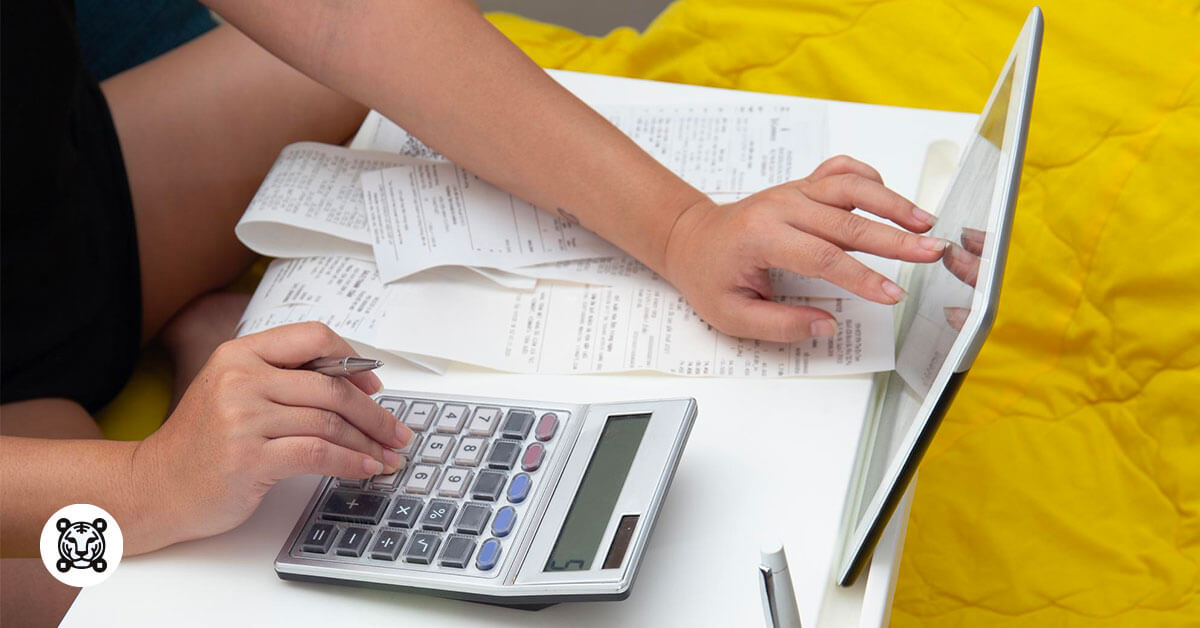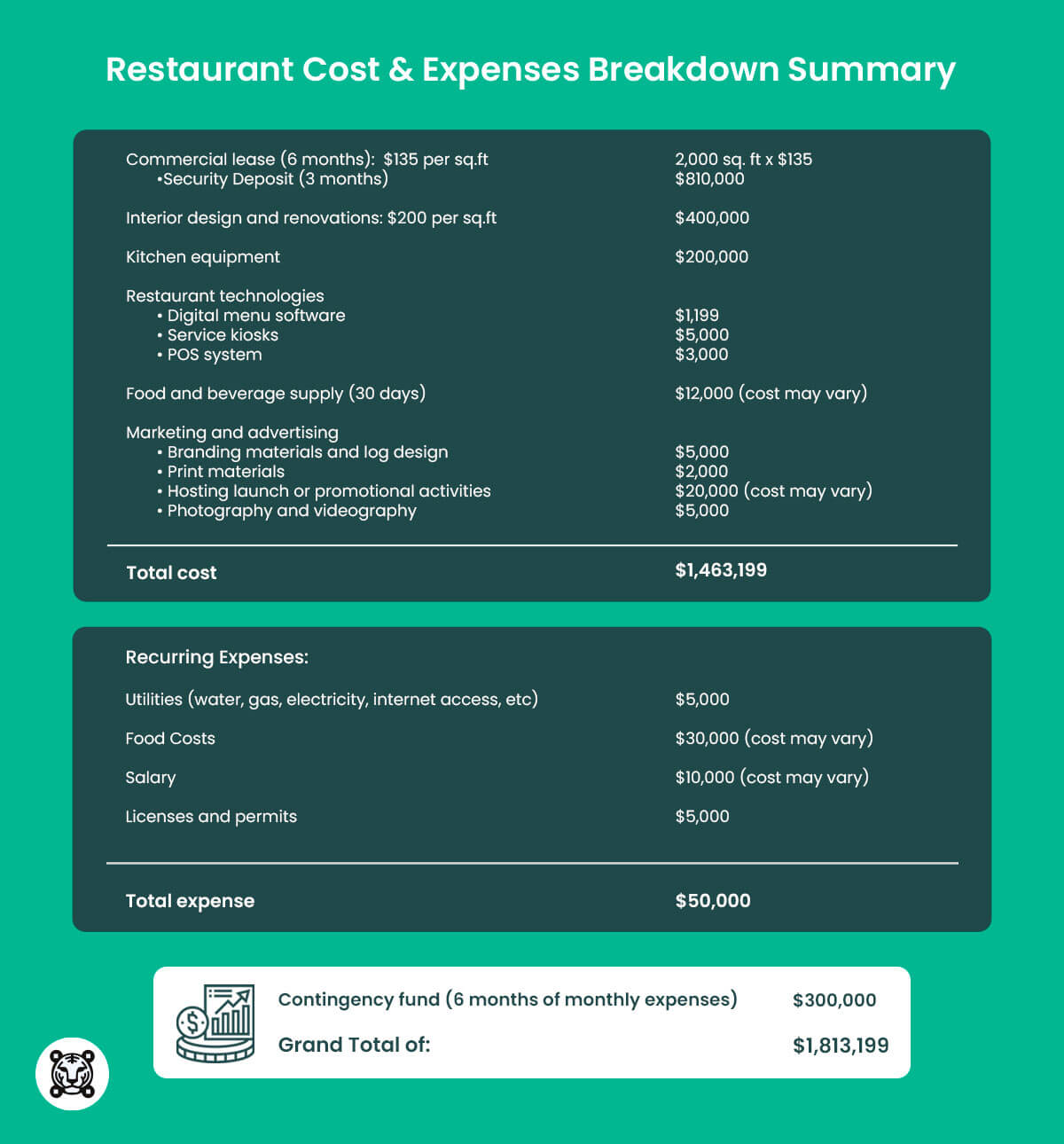
The Total Restaurant Cost Needed for Startups in New York
Last Updated: April 19, 2025
Making your restaurant dream come to life in the global hub of business and commerce comes with a hefty price tag.
“How much do I need to open a restaurant?” you may ask.
The Houston Chronicle, one of the largest US-based daily newspapers, featured the famous restaurateur David Chang in their 2022 article.
He highlighted that aspiring restaurant owners should expect to pay $300,000 for a small-scale restaurant and up to $10 million for a four-star establishment.
Chang’s estimated cost to open a restaurant only covers the commercial space, equipment, renovation, interior design, food and beverage supplies, and marketing.
You still have to think about the other necessary expenses such as labor, utilities, licenses, and permits, that can add to the total restaurant operating costs.
To help you with your projections, we at MENU TIGER QR code menu software have developed this costing breakdown as your guide.
Restaurant startup costs breakdown: How much you’ll need to open your business in New York
Starting a business in the most populated and busiest city in the United States is financially challenging—especially when you consider the cost to start a restaurant in such a competitive environment.
In fact, restaurant failure rate statistics showed that 60% of businesses in the industry will struggle in a year, and about 80% will have difficulty overcoming in the next five years.

One of the factors on this failure rate is costing. With its saturated market, you can expect the cost to be higher than other locations.
To give you a head start, here are the categories we will cover for your start-up costs:
Commercial space
Commercial leasing is a cost-effective way to secure a space when starting out.
It involves signing a contract for occupancy for a year or two, depending on the property owner. Securing the place may require a deposit—mostly three to six months' worth.
For example, the average median cost of rent is $135 per square foot for class-A buildings in Manhattan. If you plan to occupy a 2000-square-foot place for six months, expect a total lease price of $1,620,000.
In this scenario, you’d need $810,000 for a three-month deposit.
Interior design and renovations
This is where it gets costly. Once you have the space, you must renovate it before it is ready.
The average cost to renovate a space in NYC based on Brick Underground Real Estate can vary widely, but generally, it is between $200 and $250 per square foot. If you have a 2,000-square-foot space, you must prepare at least $400,000.
This cost may not include decor and other materials needed to complete the renovation. The total expenses you must prepare for may differ depending on the restaurant themes and concepts you’re going for.
Kitchen equipment
After the renovations, the next thing you should focus on is the kitchen equipment for your restaurant's operation.
To help you decide what to purchase, think about which ones your staff needs to do their job efficiently and effectively.
This will help you invest in essentials from the get-go. Here’s a list of the things you’ll likely need:
- Kitchen equipment: Ovens, stoves, fridges and freezers, and dishwashers
- Cooking equipment: Pots, pans, cutting boards, knives, strainers and ladles
- Service equipment: Plates, glassware, serving trays, plates, tablecloths, and utensils
- Bar equipment: Mixers, cocktail shakers, ice cube machines, and muddles
- Workspaces: Prep tables, steam tables, cold food tables, and counters
In 2019, American kitchen and restaurant supplier Sam Tell Companies disclosed that the estimated rate of kitchen equipment could cost between $40,000 and $200,000.
But note that these estimated costs can still change based on the energy efficiency, required features, and the size of your desired kitchen.
Restaurant technologies
Investing in good restaurant technology can help you streamline your services and operations. This is beneficial in the long run to provide an efficient dining experience for your customers.
Here are some valuable technologies to start with:
- Interactive menu QR code software
This provides a system where customers can browse the menu through their smartphones while streamlining operations through order tracking, cashless payments, etc.
You can get this software through digital menu providers like MENU TIGER. This food ordering software provides various subscription plans that unlock advanced features to upgrade your operations.
A monthly premium account costs $119, but if you go for an annual subscription, you can get it at $1,199, saving up to 16% of the original price.
- Self-service kiosks
These interactive touchscreens allow your customers to order without staff assistance.
The typical cost of a kiosk, including a display board, scanner, credit card reader, and receipt printer, is around $5,000.
Take note of allocating an allowance for maintenance and repairs, which can add up to the estimated cost.
- Point-of-sale (POS) systems
A POS system is a device, software, and payment service that processes transactions for retail customers.
A traditional POS system’s average cost is $2,000, which includes hardware, software, and an installation fee for the first year.
Another option you can go for is a cloud-based POS. This is cheaper than a traditional one since you can get a subscription plan or a one-time payment for as low as $1,000.
Take note: You don’t have to put up all these technologies in your restaurant at once. Choose one that best fits your needs and can help you streamline your operations.
We suggest going for a digital QR menu software or a POS system, as these two are more affordable, especially for beginners. As your business grows, you can then get a self-service kiosk.
Food and beverage supplies
This is one of the expert tips to recession-proof your restaurant business.
A well-stocked inventory ensures that the back of the house has all it needs for a smooth operation, guaranteeing a successful opening.
But remember, the cost of supplies can vary monthly depending on these factors: the menu type you’re offering, the suppliers you’re partnering with, natural conditions, increase in market size and suppliers, inflation, and industry recession, to name a few.
Suppose you’ll go with a plant-based menu. It will cost you around $6,000-$12,000 monthly.
However, you must be keen on the changing market and other factors affecting each ingredient's prices, such as inflation and environmental phenomena.
Marketing and advertising
This category may vary depending on what kind of restaurant you’re running. You won’t have to worry about this if you're running franchise restaurants—the franchise itself already handles these things.
But if it's a start-up, especially in a saturated market, this can require a hefty amount across various channels.

Here are some potential costs and considerations to keep in mind for your marketing and advertising:
- Branding materials and logo design: $2,500-$5,000
- Print materials (business cards, menus, flyers): $500-$2,000
- Hosting launch or promotional activities: Costs vary
- Photography and videography: $2,000-$5,000
Pro tip: Leverage social media platforms and advanced tools like a QR code menu for your promotions. These can help you reach as many potential customers as possible without breaking the bank.
To cater to diverse demographics, make sure to include an instruction on how to scan a menu QR code in your promotional materials.
Additional restaurant expenses for your restaurant to operate
You must also calculate operating expenses in the cost to open a restaurant to determine the approximate amount to prepare.

At the end of your first month of operation, expect the following recurring expenses:
Food costs
These are the total expenses for purchasing and preparing your menu items compared to the total revenue from selling a dish.
One way to calculate this is to know how much you spend making one dish. Here’s how you can measure the total cost using this formula:
| Cost of each ingredient + Purchasing costs = Menu item food cost |
By knowing the cost of your menu offerings, you can determine on how you will go about your restaurant menu pricing and the food cost percentage you’ll allocate in your monthly food and beverage inventory revenue.
Salaries and benefits
ZipRecruiter’s recent report shows that as of January 2024, the hourly rate for restaurant job categories like managers, front-to-house, back-to-house, and others in NYC ranges between $30 and $115.
With this data alone, you’ll be able to determine your operating hours and the number of staff you need to provide a smooth service for your customers.
Other than that, you must also include employee benefits such as health insurance and retirement contributions.
Utilities
Utility costs can add up to your total restaurant expenses quickly. These include electricity bills, gas, water, subscriptions, and internet access.
The bills may vary depending on the needs of a location with more than one season, for example, the electricity.
And when setting up a restaurant in a highly urbanized area like New York, you must provide nothing but the best service. One of the ways to do that is to offer high-speed internet access to your customers.
You may consider subscribing to internet plans and packages, ensuring they can enjoy WiFi without any delay or interruptions.
Licenses and permits
Opening a restaurant in New York requires obtaining various licenses and permits to comply with local and federal regulations.
These depend on factors such as the type of restaurant, its location, and the services offered.
To give you an idea, here are some standard licenses and permits to prepare:
- Food Handler’s Permit: $280/employee
- Food service license: $280
- Liquor License: $960
- Sales Tax Certificate of Authority: $225
- Certificate of Occupancy: $50
Contingency and miscellaneous expenses
As a restaurant owner, you must allocate for unexpected spending monthly.
To determine the amount, you must first calculate your total monthly expenses. Then, allocate for at least three to six months of operation.
Say your total expenses for a month of operation is $60,000. You need to have a $180,000 budget for the next three months.
Remember that this still changes depending on your profit margin and your expenses.
This serves as your emergency fund, which you can use in case of unforeseen events like environmental disasters or a decrease in sales in your business. This way, you’ll still be able to pay your operating expenses.
Restaurant operating cost and expenses breakdown summary

Remember: The restaurant startup cost can change due to numerous factors, including market value, suppliers, location, number of staff, and the menu offered. This list of restaurant costs is only a projection that you can benchmark in your business plan.
Tips on how to cut down your total start-up costs
- Marketing and advertising
Use social media for restaurants in your marketing and advertising instead of traditional promotion. You can save a significant amount on this since there’s no need for you to pay fees to build your presence online.
- Restaurant technologies
Leverage technologies like an interactive menu QR code software to streamline your operations.
It offers advanced features such as order and payment processing, inventory management, automated administrative tasks, and comprehensive sales reports that help you upscale overall service.
- Number of staff
Having the right amount of staff for better customer service and operation is a crucial step. But, if you’re still starting out, hiring people for a specific area in your restaurant is cost-effective—front of house and back of house.
Take also into consideration that during rush hours, you’ll need several service crews to accommodate each of your customers.
With these scenarios, it’s practical to start with a number that suits your restaurant size and gradually hire more when you expand your business.
Another cost-saving tip is using an interactive restaurant menu QR code software to cover your order and payment processing.
This means they can access your offerings through their devices without waiting for staff to accommodate them.

5 common restaurant cost mistakes to avoid overspending
Starting any business involves careful financial planning to avoid overspending and ensure long-term success.
Here are some common mistakes that you need to be aware of while opening your first restaurant:
Underestimating start-up costs
One good guide to opening a restaurant is to get a good estimate the full spectrum of your business expenses.
This is why you need to start with the basics. Conduct comprehensive research about the industry you’re going in to identify the potential costs involved in opening a restaurant.
Develop a detailed business plan that outlines estimated costs based on your gathered information. Make sure to include a contingency fund for unexpected spending.
Inadequate market research
When you don’t thoroughly understand your local market, including the demographics, competitors, and customer preferences, it creates a mismatch between what you offer and the market demands.
To avoid this, invest your time and resources in conducting thorough research in these aspects to tailor your menu and overall concepts to meet the specific needs of your customers.
Overlooking operating costs
Overspending on the ongoing operational costs can lead you to financial constraints, so make sure you develop realistic expense projections, considering your fixed and variable costs.
Regularly review and adjust the budget based on your monthly selling performance. If you see it decreasing, devise a risk management plan on how to save up.
Ignoring the use of technology
You might think that investing in technology can add to your expenses by a significant amount, so you opt not to use it at all.
On the contrary, leveraging advanced tools can help you save a lot of money.
For instance, if you integrate digital into your operations, you won’t need to hire more staff to accommodate your customers or print numerous pages for your menu. This technology will do the work for you.
Another tech worth investing in is a Kitchen Display System (KDS). This makes it easier for your chefs to view orders and avoid losing track of them, minimizing the possibility of slow service.
Neglecting innovative branding and marketing
Giving little attention to having creative and interactive ways in restaurant branding and marketing will waste your funds and hinder customer acquisition because of low visibility.
Traditional marketing methods can help—distributing flyers and business cards or posting ads in local newspapers—but these will not be as effective as doing your social media promotions.
Be a visionary when promoting your restaurant. Think outside of the box on effective marketing strategies that pique your target market’s interest. Allocate sufficient funds to the most effective market to make the most out of it.
MENU TIGER: Leveraging QR code menu technology for a cost-saving yet advanced restaurant operations
Maximizing the use of technology can help you cut down your expenses without compromising the quality of your service and overall operations.
MENU TIGER's flexible and user-friendly features can help you with that.
With its FREEMIUM plan, you'll be able to design your digital menu with a unique QR code that your customers can access at their own convenience. This streamlines your ordering and payment process and, at the same time saves an amount of money from reprinting.
Aside from that, you'll be able to build your presence online, thanks to its website builder, which you can design according to your brand's identity and link your social media accounts where you can engage with your patrons.
Your marketing and promotions made it easier using this software, where you can directly send an email to your customers with your promo deals or new offerings.

Kickstart your NY restaurant dream with the right start-up cost and cost-effective QR code menu software
Opening a restaurant in the Big Apple is a huge risk, considering the amount of money and effort you’ll have to put in. You must think of ways to set your business apart from this competitive market to achieve your desired return on investment.
But it does not mean you cannot do it; you just have to prepare yourself thoroughly before taking such a step. With the right amount of research, skills, and a bit of luck, you’ll surely make this restaurant dream of yours come to life.
For starters, this article can guide your restaurant cost planning, ensuring you’re on the right path to your business venture.
To help you better prepare for this journey, integrating technologies like MENU TIGER interactive restaurant QR code software is a smart choice.
It offers features to expedite your overall restaurant operations and a cost-saving advanced tool that can save you from breaking the bank.
Chevy
Before joining MENU TIGER's Content Team, Chevy has been dabbling in literary arts for five years, specifically creative writing in a theatre company. She loves exploring her creativity through painting, photography, and contemporary dancing.


